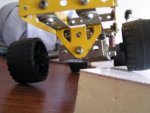Simple answer: a truck frame is not a suspension component.
A rigid mounted box, such as the one the OP has is fine if mounted properly. I have owned and driven dozens of light duty and medium duty trucks over the last 20 years, everyone having a rigid mounted box or flat bed with hundreds of thousands of miles on the chassis and no problems.
Spend your time and money on a proper suspension, designed to carry your load on the terrain you travel and you will be head and shoulders above 90% of the people doing these conversions/builds.
Heavy trucks typically have little to no suspension travel and almost zero articulation. This is to carry heavy loads on road, as previously noted. In order to carry heavy-ish loads off road, you need a compliant suspension that does not allow sway or wallow. A large camper box flopping about on your chassis is a terrible design IMO.
Rigid mount the box, presumably a properly designed rigid structure in and of itself and not a $5,000 slide in truck camper designed to live life in a pick up bed and you will be fine. This Dodge truck is a perfect example, the box is not twisting or flexing relative to the cab and the suspension is doing all the work, exaclty as it should do. A frame rail is not a suspension component.
View attachment 297753



